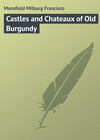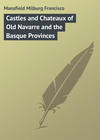Czytaj książkę: «Castles and Chateaux of Old Burgundy», strona 4
CHAPTER V
MONTBARD AND BUSSY-RABUTIN
MONTBARD lies midway between Semur and Châtillon-sur-Seine, on the great highroad leading from Burgundy into Champagne. The old Chateau de Montbard is represented only by the donjon tower which rises grimly above the modern edifice built around its base and the sprawling little town which clusters around its park gates at the edge of the tiny river Brenne.
The “grand seigneur” of Montbard was but a simple man of letters, the naturalist Buffon. Here he found comfort and tranquillity, and loved the place and its old associations accordingly. Here he lived, “having doffed his sword and cloak,” and occupied himself only with his literary labours, though with a gallantry and esprit which could but have produced the eloquent pages ascribed to him.
Buffon was a native of the town, and through him, more than anyone else, the town has since been heard of in history.
Having acquired the property of the old chateau, the donjon of which stood firm and broad on its base, he made of the latter his study, or salon de travail. This is the only remaining portion of the mediæval castle of Montbard. The ancient walls which existed, though in a ruined state, were all either levelled or rebuilt by Buffon into the dependent dwelling which he attached to the donjon. The Revolution, too, did not a little towards wiping out a part of the structure, as indeed it did the tomb of the naturalist in the local churchyard.
Buffon, or, to give him his full title, Georges-Louis-Leclerc-de-Buffon lived here a life of retirement, amid a comfort, perhaps even of luxury, that caused his jealous critics to say that he worked in a velvet coat, and that he was a sort of eighteenth century “nature-fakir.” This is probably an injustice.
In 1774 Louis XV made the “terre de Buffon” a countship, but the naturalist chose not to reside in the village of the name, but to live at Montbard some leagues away.
Montbard’s actual celebrity came long before the time of Buffon, for its chateau was built in the fourteenth century and was for centuries the possessor of an illustrious sequence of annals intimately associated with the dukedom of Burgundy.
Jean-Sans-Peur, it is to be noted, passed a portion of his youth within its walls. This gives it at once rank as a royal chateau, though that was not actually its classification. The Princesse Anne, sister of Philippe le Bon, here married the Duke of Bedford in 1423. All this would seem fame enough for Montbard, but the local old men and women know no more of their remote rulers than they do of Buffon; local pride is a very doubtful commodity.
It is disconcerting for a stranger to accost some bon homme or bonne femme to learn the way to the Chateau de Buffon, and to receive in reply a simple stare and the observation, “I don’t know the man.” Aside, to some crony, you may hear the observation, “Who are these strangers and what do they want with their man Buffon anyway?” This may seem an exaggeration, but it is not, and furthermore the thing may happen anywhere. Glory is but as smoke, and local fame is often an infinitesimal thing. Vanitas vanitatum et omnia vanitas!
Buffon wrote his extensive “Histoire Naturelle” at Montbard. It created much admiration at the time. To-day Buffon, his work and his chateau are all but forgotten or ignored, and but few visitors come to continue the idolatry of Jean Jacques Rousseau, who kissed the “seuil de la noble demure.”
Not long since, within some few years at any rate, a former friend of Alfred de Musset quoted some little known lines of the poet on this “berceau de la histoire naturelle,” with the result that quite recently the local authorities, in establishing the Musée Buffon, have caused them, to be carved on a panel in the naturalist’s former study at the chateau.
“Buffon, que ton ombre pardonne
A une témérité
D’ajouter une fleur à la double couronne
Que sur ton front mit l’Immortalité.”
Buffon’s additions to the old chateau were made for comfort, whatever they may have lacked of romanticism. The French Pliny was evidently not in the least romantically inclined, or he would not have levelled these historic walls and the alleyed walks and gardens laid out in the profuse and formal manner of those of Italy. The result is a poor substitute for a picturesque grass-grown ruin, or a faithfully restored mediæval castle.
Between the Brenne and a canal which flows through the town rises an admirable feudal tower indicating the one time military and strategic importance of the site. It is called Mont Bard, and marks where once stood the fortress that surrendered in its time to the “Ligueurs.”
Near Montbard is a hamlet which bears the illustrious name of Buffon, but it is doubtful if even a few among its three hundred inhabitants know for whom it is named.
Still further away, on the Châtillon road, is the little town of Villaines-en-Dumois, a bourg of no importance in the life of modernity. It is somnolent to an extreme, comfortable-looking and apparently prosperous. The grand route from Paris to Dijon passes it by a dozen kilometres to the left, and the railway likewise. Coaching days left it out in the cold also, and modern travel hardly knows that it exists.
In spite of this the town owns to something more than the trivial morsels of stone which many a township locally claims as a chateau. Here was once a favourite summer residence of the Burgundian dukes, and here to-day the shell, or framework, of the same edifice looks as though it might easily be made habitable. The property came later to the Madame de Longueville, the sister of the Grand Condé. There is nothing absolutely magnificent about it now, but the suggestion of its former estate is still there to a notable degree. The walls and towers, lacking roofs though they do, well suggest the princely part the edifice once played in the life of its time.
In spite of the fact that the name of the town appears in none of the red or blue backed guide-books, enough is known of it to establish it as the former temporary seat of one of the most formal of the minor courts of Europe, where – the records tell – etiquette was as strict as in the ducal palace at Dijon. Four great round towers are each surrounded by a half-filled moat, and the suggestion of the old chapel, in the shape of an expanse of wall which shows a remarkably beautiful ogival window, definitely remains to give the idea of the former luxury and magnificence with which the whole structure was endowed.
A detached dwelling, said to be the house of the prior of a neighbouring monastery who attached himself to the little court, is in rather a better state of preservation than the chateau itself, and might indeed be made habitable by one with a modest purse and a desire to play the “grand seigneur” to-day in some petty gone-to-seed community. These opportunities exist all up and down France to-day, and this seems as likely a spot as any for one who wishes to transplant his, or her, household gods.
Beyond Montbard is Les Laumes, a minor railway junction on the line to Dijon, which is scarcely ever remembered by the traveller who passes it by. But, although there is nothing inspiring to be had from even a glance of the eye in any direction as one stops a brief moment at the station, nevertheless it is a prolific centre for a series of historical pilgrimages which, for pleasurable edification, would make the traveller remember it all his life did he give it more than a passing thought. One must know its history though, or many of the historic souvenirs will be passed by without an impression worth while.
On Mont Auxois, rising up back of the town, stands a colossal statue of Vercingetorix, in memory of a resistance which he here made against the usually redoubtable Cæsar.
Six kilometres away there is one of the most romantically historic of all the minor chateaux of France and one not to be omitted from anybody’s chateaux tour of France. It is the Chateau de Bussy-Rabutin, to-day restored and reinhabited, though for long periods since its construction it was empty save for bats and mice. This restoration, which looks to-day like a part of the original fabric, was the conceit of the Comte de Bussy-Rabutin, a cousin of Madame de Sévigné in the seventeenth century. It gives one the impression of being an exact replica of a seigneurial domain of its time.
The main fabric is a vast square edifice with four towers, each marking one of the cardinal points. The Tour du Donjon to the east, and the Tour de la Chapelle to the west are bound to a heavy ungainly façade which the Comte Roger de Bussy-Rabutin built in 1649. This ligature is a sort of a galleried arcade which itself dates from the reign of Henri II.
As to its foundation the chateau probably dates from an ancestor who came into being in the twelfth century. In later centuries it frequently changed hands, until it came to Leonard du Rabutin, Baron d’Epiry, and father of the Comte Roger who did the real work of remodelling. It was this Comte Roger who has gone down to fame as the too-celebrated cousin of Madame de Sévigné. To-day, the chateau belongs to Madame la Comtesse de Sarcus and although it is perhaps the most historic, at least in a romantic sense, of all the great Renaissance establishments of these parts, it is known to modern map-makers as the Chateau de Savoigny. Much of its early history is closely bound with that picturesque owner, Comte de Bussy-Rabutin.
In Holy Week in 1657, at the age of forty-one, Bussy became involved in some sort of a military scandal and was exiled from France. The following year he made peace with the powers that be and returned to court, when he composed the famous, or infamous, “Histoire Amoureuse des Gaules,” a work of supposed great wit and satirical purport, but scandalous to a degree unspeakable. It was written to curry favour with a certain fair lady, the Marquise de Monglat, who had an axe to grind among a certain coterie of court favourites. Bussy stood her in great stead and the scheme worked to a charm up to a certain point, when Louis XIV, not at all pleased with the unseemly satire, hurried its unthinking, or too willing, author off to the Bastile and kept him there for five years, that no more of his lucubrations of a similar, or any other, nature should see the light.
In 1666 Bussy got back to his native land and was again heard of by boiling over once more with similar indiscretions at Chazeu, near Autun. Finally he got home to the chateau and there remained for sixteen consecutive years, not a recluse exactly, and yet not daring to show his head at Paris. It was a long time before he again regained favour in royal circles.
The Cour d’Honneur of the chateau is reached by a monumental portal which traverses the middle of the corps du logis. Above this are two marble busts, one of Sainte-Jeanne-de-Chantal, which came originally from the Couvent de Visitation at Dijon, and the other of Colbert, the minister of Louis XIV.
The ancient Salle des Devises (now the modern billiard room) has a very beautiful pavement of hexagonal tiles, and a series of allegorical devises which Bussy had painted in 1667 by way of reproach to one of his feminine admirers. On other panels are painted various reproductions of royal chateaux and a portrait of Bussy with his emblazoned arms.
The Salon des Grands Hommes de Guerre, on the second floor, is well explained by its name. Its decorations are chiefly interlaced monograms of Bussy and the Marquise Monglat, setting off sixty odd portraits of famous French warriors, from Duguesclin and Dunois to Bussy himself, who, though more wielder of the pen than the sword, chose to include himself in the collection. Some of these are originals, contemporary with the period of their subjects; others are manifestly modern copies and mediocre at that, though the array of effigies is undeniably imposing.
The Chambre Sévigné, as one infers, is consecrated to the memory of the most famous letter writer of her time. For ornamentation it has twenty-six portraits, one or more being by Mignard, while that of “La Grande Mademoiselle,” who became the Duchesse de Berry, is by Coypel.
Below a portrait of Madame de Sévigné, Bussy caused to be inscribed the following: “Marie de Rabutin: vive agreable et sage, fille de Celse Béninge de Rabutin et Marie de Coulanges et femme de Henri de Sévigné.” This, one may be justified in thinking, is quite a biography in brief, the sort of a description one might expect to find in a seventeenth century “Who’s Who.”
Beneath the portrait of her daughter – Comtesse de Grignan – the inscription reads thus: “Françoise de Sévigné; jolie, amiable, enfin marchant sur les pas de sa mere sur le chapitre des agreements, fille de Henri de Sévigné et de Marie de Rabutin et femme du Comte de Grignan.” A rather more extended biography than the former, but condensed withal.
Another neighbouring room is known as the Petite Chambre Sévigné, and contains some admirable sculptures and paintings.
Leading to the famous Tour Dorée is a long gallery furnished after the style of the time of Henri II, whilst a great circular room in the tower itself is richly decorated and furnished, including two faisceaux of six standards, each bearing the Bussy colours.
Legend and fable have furnished the motive of the frescoes of this curious apartment, and under one of them, “Céphale et Procris,” in which one recognizes the features of Bussy and the Marquise, his particular friend, are the following lines:
“Eprouver si sa femme a le cœur précieux,
C’est être impertinent autant que curieux:
Un peu d’obscurité vaut, en cette matière,
Mille fois mieux que la lumière.”
Not logical, you say, and unprincipled. Just that! But as a documentary expression of the life of the times it is probably genuine.
Here and elsewhere on the walls of the chateau are many really worthy works of art, portraits by Mignard, Lebrun, Just, and others, including still another elaborate series of fourteen, representing Richelieu, Louis XIII, Anne d’Autriche, Mazarin, Louis XIV. Again in the plafond of the great tower are other frescoes representing the “Petits Amours” of the time, always with the interlaced cyphers of Bussy and Madame la Comtesse.
From the Chambre Sévigné a gallery leads to the tribune of the chapel. Here is a portrait gallery of the kings of the third race, of the parents of Bussy, and of the four Burgundian dukes and duchesses of the race of Valois. The chapel itself is formed of a part of the Tour Ronde where are two canvasses of Poussin, a Murillo and one of Andrea del Sarto.
The gardens and Park of the chateau are attributed to Le Notre, the garden-maker of Versailles. This may or may not be so, the assertion is advanced cautiously, because the claim has so often falsely been made of other chateau properties. The gardens here, however, were certainly conceived after Le Notre’s magnificent manner. There is a great ornamental water environing the chateau some sixty metres in length and twelve metres in width, and this of itself is enough to give great distinction to any garden-plot.
CHAPTER VI
“CHASTILLON AU NOBLE DUC” (The War Cry of the Bourguignons)
THE importance of the ancient Chastillon on the banks of the Seine was entirely due to the prominence given to it by the Burgundian dukes of the first race who made it their preferred habitation.
The place was the ancient capital of the Bailliage de la Montague, the rampart and keep to the Burgundian frontier from the tenth to the fifteenth century.
The origin of the Chateau des Ducs is blanketed in the night of time. Savants, even, can not agree as to the date of its commencement. One says that it and its name were derived from Castico, a rich Sequanais; and another that it comes from Castell, an enclosed place; or from Castellio – a small fortress. Each seems plausible in the absence of anything more definite, though according to the castle’s latest historian it owes its actual inception to the occupation of the Romans who did build a castrum here in their time.
During the pourparlers between Henri IV and the League, the inhabitants of the city demanded of Nicolas de Gellan, governor of the place, the giving up of the castle which had for years been the cause of so much misery and misfortune. The place had been the culminative point of the attacks of centuries of warriors, and the inhabitants believed that they had so suffered that it was time to cry quits.
When the surrender, or the turning over, of the castle took place, all the population, including women and children, marched en masse upon the structure, and wall by wall and stone by stone dismantled it, leaving it in the condition one sees it to-day. A castle of sorts still exists, but it is a mere wraith of its former self. There is this much to say for it, however, and that is that its stern, grim walls which still stand remain as silent witnesses to the fact that it was not despoiled from without but demolished from within. Peace came soon after, and the people in submitting to the new régime would not hear of the rebuilding of the chateau, and so for three hundred years its battered walls and blank windows have stood the stresses of rigorous winters and broiling summers, a silent and conspicuous monument to the rights of the people.
The majestic tower of the chateau, for something more than the mere outline of the ground-plan still exists, is bound to two others by a very considerable expanse of wall of the donjon, and by the courtines which formerly joined the bastions with the main structure.
The suggestion of the ample inner court is still there, and the foundations of still two other towers, as well as various ruined walls. A neighbouring edifice, the buildings formerly occupied by the Canons of Saint Vorles, is inexplicably intermingled with the ruins of the chateau in a way that makes it difficult to tell where one leaves off and the other begins. The chevet of the Eglise de Saint Vorles and its churchyard also intermingle with the confines of the chateau in an extraordinary manner. To say the least, the juxtaposition of things secular and ecclesiastic is the least bit incongruous.
Châtillon’s Tour de Gissey, practically an accessory to the chateau, is a noble work whose well-preserved existence is due entirely to the solidity of its construction. Its lower ranges are of the twelfth and thirteenth centuries, but its upper gallery and its row of meurtrières were due to the military engineers of Henri IV. who sought to make it the better serve the purpose of their royal master.
Within this tower are two fine apartments, of which the upper, known as the Salle des Gardes, was, before the Revolution, the sepulchre of certain wealthy neighbouring families.
Within the limits of the plot which surrounds the chateau, the church and the tower, is the tomb of Maréchal Marmont, Duc de Raguse.
The present edifice at Châtillon occupied by the Sous-Préfecture was built, as a plaque on the wall indicates, by Madame la Comtesse de Langeac in 1765. It is a fine example of the architecture of the period which, in spite of glaring inconsistencies to be noted once and again, is unquestionably most effective, and suggests that after all the chateau filled its purpose well as a great town house of a wealthy noble. The building plays a public part to-day, and if it serves its present purpose half as well as its former, no one should complain. Within this really superb and palatial structure is still to be seen the magnificent stairway of forged iron of the period of Louis XVI. Besides this are various apartments with finely sculptured wooden panels and rafters of the same epoch, all of which accessories were brought thither from the nearby Chateau de Courcelles-les-Ranges, demolished during the Revolution.
The Chateau de Marmont at Châtillon was formerly the princely residence of the Maréchal de Marmont, rebuilt from the fifteenth century chatelet occupied by the Sires de Rochefort, who were simply the appointed chatelains of the Duc de Bourgogne, to whom the property really belonged.
In various successive eras the edifice was transformed, or added to, until it took its present form, the gradual transformation leaving little or no trace of its original plan.
The Maréchal de Marmont, one of Châtillon’s most illustrious sons, would have transformed his native city into a Burgundian Versailles, or at least a “Garden City.” He did found a great agricultural enterprise, of which the chateau, its gardens and its park, formed the pivot. Too enterprising for his times, the Duc de Raguse saw himself ruined, and then came the German invasion of ’71, when, in a combat with the Garibaldians, the chateau was burned.
Châtillon has perpetuated the name of its great man in the public place, and also by naming one of the principal streets for him, but has not yet erected a statue to him. This indeed may be a blessing in disguise. Statues in trousers are seldom dignified, and this noble duke lived too late for cloak and sword or suit armour.
The Chateau de Marmont, so called even to-day, was rebuilt after the fire and now serves a former Maire of the city as his private residence.
Châtillon-sur-Seine was – though all the world seems to have forgotten or ignored it – the seat of a convention in 1814 which proposed leaving France its original territorial limits of 1792, a proposition of the ambassadors which was utterly rejected by Napoleon.
Albeit that Châtillon lies on the banks of the Seine it is well within the confines of Burgundy. Roundabout is a most fascinating and little exploited region.
Thirty kilometres to the north is Bar-sur-Seine and to the northwest Brienne-le-Chateau, where the Corsican first learned the rudiments of the art of war.
“La grand’ville de Bar-sur-Seine a fait trembler Troyes en Champaigne!” Poor grand’ville! To-day it is withered and all but dried up and blown away. Poor grand’ville! It is the same of which Froissart recounts that it lost in one day the houses of nine hundred “nobles et de riches bourgeois” by fire. Without doubt these houses were of wooden frames and offered but little resistance to fire, as the period was 1359. Afterwards the town was rebuilt and became again populous and rich. Then began the decadence, until to-day it is the least populous “chef-lieu” of the department. Its population is, and ever has been, part Bourguignon and part Champagnois, the latter province being but a league to the northward, where, on the actual boundary, is found the curiously named little village of Bourguignons.
South from Châtillon, across the great forest of the same name, one of the great national forests of France so paternally cared for by the Minister for Agriculture, is the actual source of the Seine. Here is what the engineers call a “Chateau d’Faux,” though there is little enough of the real chateau of romance about it. It is simply a head-house with an iron grille and various culverts and canals and what not which lead the bubbling waters of the Seine to a wider bed lower down, there to continue their way, via Paris, to the sea.
A classic sculpture, typifying the Source of the Seine, has been erected commemorating the achievement of the engineers, but appropriate as the sentiment is it has not prevented the dishonouring hand of that abominable certain class of tourist of graving its names and dates thereon.
The Seine at this point is nothing very majestic. It is simply a “humble filet que le nain vert, Oberon, franchirait d’un bond sans mouiller ses grelots.” All Frenchmen, and Parisians in particular, have a reverence for every kilometre of the swift-flowing waters of the Seine. This is perhaps difficult for the stranger, who may be familiar with greater if less historic streams at home, to appreciate until he has actually discussed the thing with some Frenchman. Then he learns that it is the Frenchman’s Niagara, Mississippi and Yosemite and Pike’s Peak all rolled into one so far as his worship goes.
Midway between Châtillon and the source is Duesme, a smug, unheard of little hamlet, the successor of a feudal bourg of great renown in its day. The sparse ruined walls still suggest the pride of place which it once held when capital of the powerful Burgundian Countship of Duesme. Its walls are still something more than mere outlines, but the manorial residence has become one of those “walled farms,” so called, so frequently seen, and so unexpectedly, in the countryside of France. Here and there a gate-post, a wall or a gable, is as of old, and two great ornamental vases support the entrance to the alleyed row of trees which leads from the highroad to the dwelling, suggesting, if in a vague way, the old adage, “Other days, other ways.”
The fall of this fine old feudal residence has been great, but the present occupant – if he has a thought or care for such things – must be content indeed with such a princely farm-house. It must be a fine thing to raise chickens and other barn-yard livestock amid such surroundings!



















